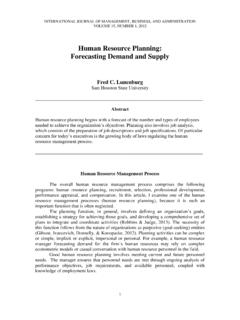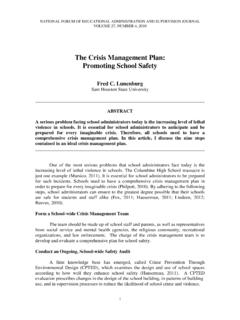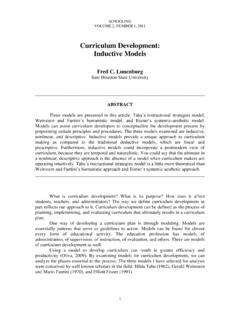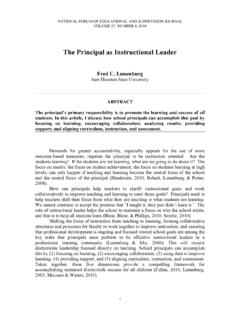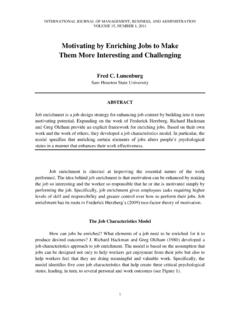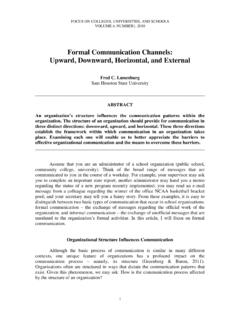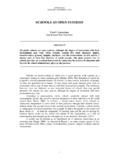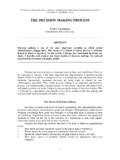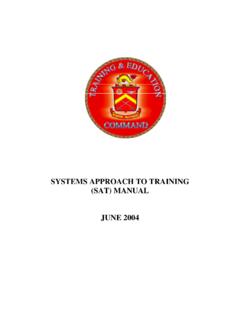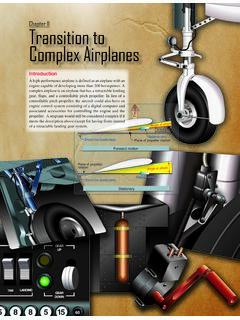Transcription of Performance Appraisal: Methods and Rating Errors
1 INTERNATIONAL JOURNAL OF SCHOLARLY ACADEMIC INTELLECTUAL DIVERSITY VOLUME 14, NUMBER 1, 2012 1 Performance Appraisal: Methods and Rating Errors Fred C. Lunenburg Sam Houston State University ABSTRACT Performance appraisal is the systematic observation and evaluation of employees Performance . Some of the most commonly used Performance appraisal Methods include the judgmental approach , the absolute standards approach , and the results-oriented approach . Ideally, Performance appraisal should be completely accurate and objective.
2 However, the Performance appraisal process is far from accurate and objective, sometimes resulting in Rating Errors . Common Rating Errors include strictness or leniency, central tendency, halo effect, and recency of events. Virtually every organization has a formal employee Performance appraisal system. Performance appraisal may be defined as the process by which superiors evaluate the Performance of subordinates, typically on an annual or semiannual basis for the purpose of determining raises, promotions, or training needs (Grote, 2011).
3 There are a number of alternative Performance appraisal Methods , each with their own strengths and weaknesses that make them more appropriate for use in some situations than in others (Dessler, 2012). Further, it is assumed that superiors accurately appraise their subordinates Performance , leading to unbiased and objective judgments. However, the Performance appraisal process is far from objective, sometimes resulting in Rating Errors (Guerra-Lopez, 2009). Performance Appraisal Methods Organizations currently use several Methods to appraise Performance .
4 For the sake of simplicity, we can group them into three categories: the judgmental approach , the absolute standards approach , and the results-oriented approach (Bratton, 2012; Dessler, 2012). INTERNATIONAL JOURNAL OF SCHOLARLY ACADEMIC INTELLECTUAL DIVERSITY 2_____ Judgmental approach A manager or Performance appraiser is asked to compare an employee with other employees and rate the person on a number of traits or behavioral dimensions. These appraisal systems are based on the exercise of judgment by the superior.
5 Four widely used judgmental approaches are graphic Rating scales, ranking, paired comparison, and forced distribution. Graphic Rating scales. A popular, simple technique for evaluating employees is to use a graphic Rating scale. Table 1 shows a typical Rating scale for a manager. Note that the scale lists a number of important work dimensions (such as leadership and management) and a Performance range for each one. For each work dimension, the evaluation scheme is typically used to assess the important work dimensions: (1) unacceptable, (2) needs improvement, (3) acceptable, (4) commendable, and (5) outstanding.
6 The assigned values for each dimension are then added up and totaled. Table 1 Abbreviated Graphic Rating Scale for Managers Ranking. An alternative method to graphic Rating scales involves managers ranking their subordinates in order of their Performance effectiveness from best to worst. The usual procedure requires the rater to write the name of the best subordinate on the top of a list, then the name of the worst at the bottom and continue this sequential procedure until all subordinates are listed. Ranking is most frequently used for making decisions such as promotions or the merit salary increase each employee will receive.
7 Paired comparison. A modification of the ranking procedure is the paired comparison technique. The method overcomes the problem associated with differentiating between subordinates in the middle range of the distribution. Under paired comparisons, raters compare only two subordinates at a time until all two-way comparisons have been made among all employees. After Rating all pairs, the manager can put the subordinates into a rank order by counting up the number of times each employee has been judged superior.
8 Work Dimension Unacceptable Needs Improvement Acceptable Commendable Outstanding Leadership 1 2 3 4 5 Management 1 2 3 4 5 Personnel administration 1 2 3 4 5 Administrative teaming 1 2 3 4 5 Budgeting 1 2 3 4 5 FRED C. LUNENBURG _____3 Forced distribution. Grading on a curve is a good example of the forced distribution method of Performance appraisal. With this technique, the rater places a predetermined percentage of rates into four or five Performance categories. For example, if a five-point scale is used, the manager might decide to distribute employees as follows: 5 percent in the unacceptable category, 25 percent in the needs improvement category, 40 percent in the acceptable category, 25 percent in the commendable category, and 5 percent in the outstanding category.
9 The usual procedure for accomplishing such a distribution is to record each employee s name on a separate index card. Then, for each dimension being appraised (leadership, management, etc.), the employee s index card is placed in one of the five categories. Absolute Standards approach Most appraisal measures that employ an absolute standards approach are based on job analysis. As discussed earlier, this type of analysis can provide a more detailed description of the actual behavior necessary for effective Performance .
10 Managers compare the Performance of each employee to a certain standard instead of to the Performance of other employees; thus, they rate the degree to which Performance meets the standard. The most common Performance appraisal processes in this group are checklists, essays, critical incidents, and behaviorally anchored Rating scales. Checklists. The most common technique in the absolute standards group is some sort of checklist. Checklists tend to be more behaviorally based than either graphic Rating scales or other employee-comparison Methods .

